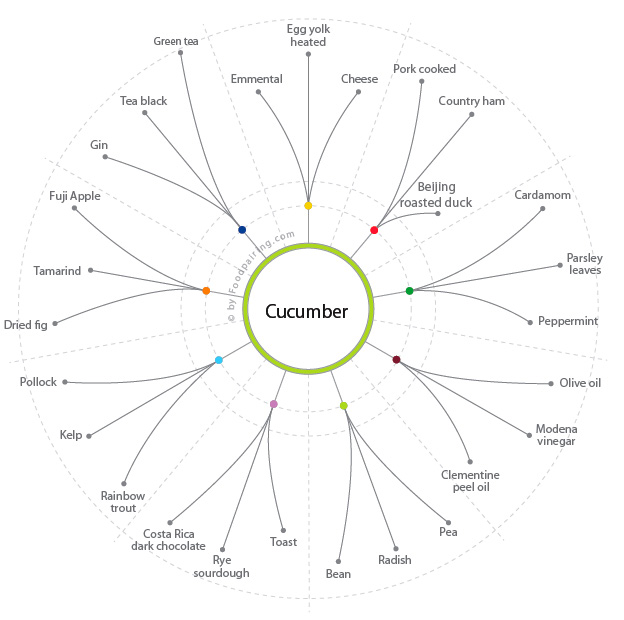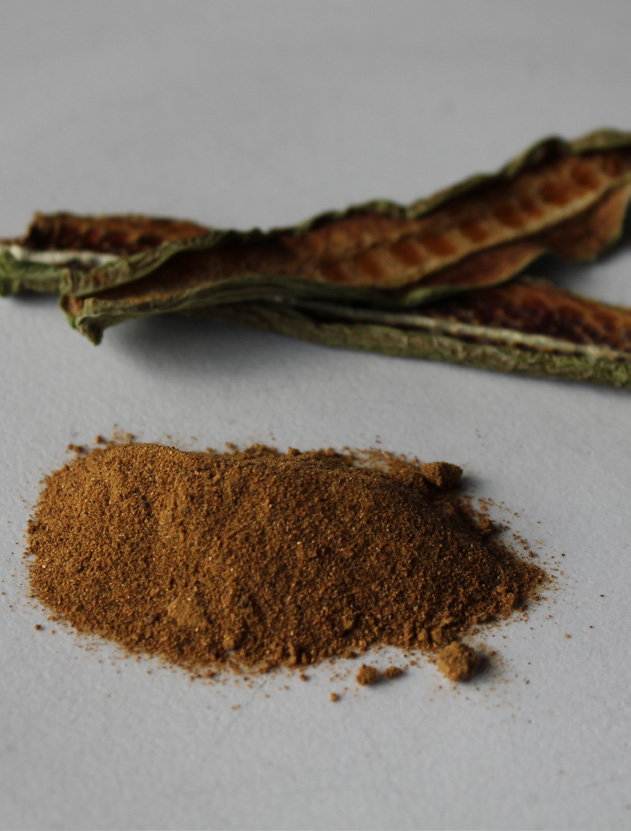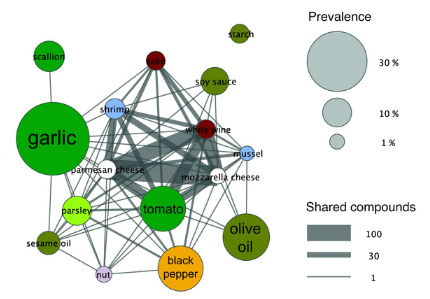by Ben Reade.
“The Creator, in making man eat in order to live,
persuaded him by appetite and rewarded him by pleasure.”
(Jean Anthelme Brillat-Savarin, 1825)
In this section we explore flavour, focusing on using the available scientific knowledge to help chefs and other food industry professionals to develop new concepts, techniques and recipes. As chef Andoni Luis Aduriz of the famous Basque restaurant Mugaritz writes (in collaboration with Arboleya et al (2008), “cooking and science are well placed to work in harmony for both the development and realization of innovative and [healthy] dishes.”While studying how, at NFL, scientific knowledge can help chefs utilize the full potential of ingredients, novelty should not be pursued for it’s own sake. While new techniques can and should be used when relevant, these are tools to achieve an end, the end being more important than the means (Adria et al 2006).
Components of flavour perception
(i) Tastes – perceived soluble molecules in the mouth, commonly listed as the tastes for sweet, salt, sour, bitter, umami.
(ii) Aroma – ortho-nasal perception through the nostrils on inhale and retro-nasal perception which occurs during exhale – it is suggested that humans are particularly well adapted for retro-nasal odor perception (Shepard, 2012).
(iii) Trigeminal nerve sensations that include chemesthesis (pungency (garlic), hotness (chili) or freshness (mint)) as well as feelings of temperature, pain, texture, touch etc.
(iv) Other senses, for example audition and vision, may play an effect on perceived food flavour.
(v) Complex ecological parameters such as hunger level, expectancy, cultural background, social situation or anxiety may also have an effect on perceived flavour.
The most important thing in food preparation is achieving a delicious flavour. Everything else comes second. It has been shown again and again that the flavour of a food is key to its acceptability (Ahn, 2011. Klosse et al, 2004).
Taste and smell are the body’s principle mechanism for assessing the chemical composition of foods, for both nutrients and toxicity (Chandrasekhar, 2006;, Morini, 2007;, Sell, 2006). They are known as the ‘chemical senses’ and they are the oldest senses we have. We are rewarded by food that gives us nutrients with good taste, we find certain foods pleasurable, because they benefit us. ‘Quot sapit nutrit’ (from Latin as:‘If it tastes good, it’s good for you’). From the perspective of a ‘Darwinian gastronome’ humans have evolved tastes for certain chemicals which give us pleasure because of their nutritional benefits, not for some innate feature of the ingredient itself (Darwinian gastronomy – defined by Sherman et al (2005), refersto the phenomenon by which man has evolved taste preferences for foods which have led to ‘evolutionary’ benefits, for example, health and fitness). Preferences evolve to match the foods which benefit us, (Sherman 2005, Morini 2007, Meyerhof, 2005). Quite clear examples of this phenomenon can be seen in some of the basic tastes. For example, sweetness is an indicator of sugar levels, thereby sweetness is a key in recognizing rich calorie sources in our environment. The taste umami is triggered principally by the amino acid Glutamate. Amino acids are the basic building blocks of proteins, so by this logic the human desire to eat foods perceived as umami can be seen as a biological and evolved mechanism of recognizing proteins in our food environment, rewarding the body with pleasure when we find them.
Our aversion to certain tastes, such as the overly acidic; or smells, such as that of amines or mercaptans, is almost certainly an evolved mechanism to steer us away from toxic substances or food spoiled by bacterial decomposition, and thereby away from food poisoning (Sell 2006).
Indeed some particularly striking examples of this occur in the cultural phenomena of spicing food. Spices, due to their high bioactivity and pharmacological properties have been the focus of extensive studies, many of which suggestthat these ingredients have been selected through human experimentation over millennia on account of their anti-microbial properties (Sherman and Hash, 2001; Sherman, 2005). One example of humans finding plants with particular aromas appealing can be found with Myrrh (resin of Commiphora abyssinica). Myrrh has been used in perfumery, and food preparation since ancient times. (Sell, 2006) It just happens to have very strong antifungal and antibacterial properties – a coincidence that we find such a potent medical product pleasurable? Probably not.
To form part of a cultural cache (the complete collection of cultural knowledge of a given society),a recipe must prove useful to a culture. The fitness of an ingredient or technique to form part of a traditional cuisine is at least in part defined by the flavour it gives (as well as nutritional benefits). As cultural ideas are cross fertilized with cultural migrations and commercial exchanges instead of instead of an inevitable homogenization of food cultures, an overall increase of the diversity of local food cultures may be expected. This is due to each society using importe[get_bloginfo]url[/get_bloginfo]/files/blog/2012/03/d customs in their capacity as bricoleurs they use mixtures of an ever increasing number of available ingredients and techniques to create new ways of eating (Montanari, Massimo (2008) adapted from personal conversation). At NFL a consciouseffort is made to expand this constant building on past experience aiming to create new pillars of local gastronomy in a diverse world.
In any traditionalsituation, the number of recipes held within a culture is never sufficient to completely explore the possibilities of available ingredients and even in the case of the invasion of a new ingredient, which has high level of fitness to be adapted to a local cuisine, the chances of the said ingredient ever completely replacing the local analogue is low, as with the passing of time, local products and processes become in some sense frozen in culture(Kinouchi et al, 2008).
We can note a type of gastronomic ‘founder effect’analogous to that of evolutionary biology within ingredient selection patterns. The ‘founder effect’ is a loss of diversity due to a small number of individuals starting an isolated population, or, in our gastronomic analogue, a small number of ingredients available to a society during its early development, may mean that the society develops techniques for processing limited numbers of ingredients, and never fully adapts to alien techniques or ingredients. The practice of this means that regardless of the invasion by alien ingredients and recipes, the idiosyncrasies of a local cuisine will rarely disappear. (Kinouchi et al, 2008) While fear of cultural ‘dilution’ is completely understandable, some mixing is inevitable. Perhaps we should encourage adopting foreign ingredients or cultural practices, i.e. recipes and techniques and assimilating them into our own cultures, but only if they can find a suitable place within the culture. They will only add to the wealth of ingredients with which one can experiment. Indeed, the 8th point in The Manifesto of a New Nordic Cuisine states this purpose clearly:
“To combine the best in Nordic cookery and culinary traditions with impulses from abroad.”
In trying to discover new dishes, many have looked for patterns or systems of logic used in flavour combinations. Particularly interesting theories have emerged recently, especially the flavour-pairing hypothesis that was put forward in 1992 by Heston Blumenthal of The Fat Duck and Francois Benzi of Firmenich.
The theory states that foods that share prominent flavour compounds, will sit harmoniously together. This theory was taken forward by the Belgian, Bernard Lahousse founder of the website www.foodpairing.com, and after lengthy experimentation by other top Belgian chefs, such as Sang Hoon Dengiembre of L’Air du Temps and Sergio Herman of Oul Sluis the website now receives considerable attention from food and beverage professionals.
By analyzing aromatic profiles of ingredients using gas chromatography coupled mass spectrometry (GC-MS) ingredients are inserted into a database. Following this ingredients can be looked at in a tree format, with all the other ingredients with which there was a cross over of aromatic content (See cucumber flavour ‘tree’ below). This system is now used by some of the world’s top chefs as a methodology of discovering new flavour combinations. Previous examples of these have been, caviar with white chocolate, liver with jasmine, beef with coffee or chocolate and blue cheese. However the prevalence of shared compounds should be taken only as an indicator of compatibility, and may not show in any way, how ingredients may have been used in traditional cuisine.

At NFL when investigating new seasonings and spices a period was spent dehydrating many different foods, and powdering them in order to obtain spices that can be used many ways. It was discovered that peeled cucumber responded particularly well to this treatment. While attempting to find uses for this (possibly) ‘new’ spice (which has a surprisingly ‘middle eastern’ flavour), it was found that looking at the flavour pairing tree for cucumber gave us lists of ingredients and many ideas for combinations.

Putting the food pairing hypothesis to the test, researchers Ahn et al (2011), studied patterns of ingredient combination in 56,498 different recipes. Using topological network patterns between recipes, it was found that patterns in flavour combinations differed relative to geographical location. It seems that combination principles may not transcend food cultures. In North American and Western European cuisines there is a high likelihood of recipes where ingredients share flavour compounds. However East Asian and southern European recipes were more likely to avoid flavour compound overlap (Ahn, 2011).

Analyzing pre-existing recipes is one way of trying to give some logic to recipe invention. By using scientific algorithms for both combination and processing, predictive models of cookery experimentation may be born, hopefully leading to a predictionof acceptability of a plate, before it is created, this providing alink from theories to practical problem solving, thereby allowing chefs to create relatively fewer experiments, to achieve calculated results.
An analysis of the most successful plates of 18 Michelin starred chef in the Netherlands led Klosse et al (2004) to the conclusion that there were various things which all of these plates held in common. It was hypothesized that the palatability and acceptance of dishes by diners can be improved by remembering the following ‘culinary success factors’.
Culinary Success Factors
(i) Name and presentation fit the expectation
(ii) Appetizing smell that fits the food
(iii) Good balance of flavour components in relation to the food
(iv) Presence of umami taste
(v) In mouth-feel a mix of hard and soft textures
(vi) High flavour richness (Klosse et al, 2004)
It is now worth a brief exploration of each of these points,
(i) Yeomans et al (2007) have found that name and presentation may be less important with highly novel foods such as the smoked salmon ice cream with which they experimented.
(ii) Aromas should match colours, as diners may discount their nasal perception on account of misleading information available from the visual senses. (Morrot, 2001)
(iii) Flavour balance should be kept, not serving any dishes that are too rich in any of the 5 basic tastes. It is worth noting that in nature, often sweet and sour tastes come together (for example in fruit).Salty and umami tastes are frequently served together, for example with salted meat, although the salt normally comes through human addition.Many flavours in nature are not particularly sensitive to concentration: add more apricot to yogurt: it becomes sweeter and more acidic and it will taste more of apricot, this can be continued until there is only the apricot with a tiny amount of yogurt, it may serve a different purpose, but if it’s a good apricot it will not be out of balance (Taylor, 2002). With powerful seasonings and spices it is important to remember that too much can be overwhelming.
(iv) Not only L-Glutamate is perceived as umami.Other molecules, such as 5’-IMP and 5’-GMP are highly synergistic with glutamate, very small quantities can increase overallumami taste and hedonic rating (Zhang et al, 2008) (More on this in a later post).
(v) It was seen in the report as crucial to have a mixtures of textures in a certain plate. For example having something crispy or crunchy on one side with something juicy, creamy or moist on the other (Klosse et al, 2005). Drawing from humanitarian sciences, perhaps it is interesting at this point to consider how meals were constructed to be considered balanced in the times when Hippocratic medicine was the prevalent dietetic doctrine. The strength (for a chef) of this philosophical approach to diet construction is the emphasis on balance. In order to obtain this balance the diet, and for our uses perhaps the individual plate should be balanced between the four elements; air, fire, earth and water; in order to maintain a stable humor. Each of the elements, was held as having its particular qualities:air which is hot and moist; fire, being hot and dry; earth being dry and cold and water, which is cold and wet. In this system of dietetics, a balanced plate of food would represent each of the four elements so as not to cause dietaryimbalance in the consumer. I suggest that by using this ancient philosophy, chefs can construct plates which represent (if only to themselves) each of the four, thereby giving a framework on which to build an aesthetically balanced meal. See diagram below of the hippocratic elements.
(vi) Flavour richness can be improved by many techniques. However, without adjusting the food itself, more flavour compounds are released with increased mastication. As food particles are broken down to increasingly small sizes by mastication more volatile parts leave the food and are perceived as retro-nasal aroma. Mastication also allows a greater surface area of the food to be exposed to digestive enzymes, thus increasing nutrient absorption. Food mastication can be increased by thinning the saliva (This, 2002). This works because the diner must chew more in order to achieve a homogenous paste that can be swallowed. Tannins have the effect of precipitation salivary proteins (Bajec and Pickering, 2009),which is why we feel grainy particles in our mouths when we drink tannic wine or eat astringent fruit. This has the effect of meaning a diner will have to chew more to form bolus, thus allowing them to enjoy the release of aroma for their retro-nasal benefit.

About the author
My Name is Ben Reade, I’m a chef from Edinburgh, Scotland, and for the past 3.5 years I have been studying at The University of Gastronomic Sciences in Pollenzo, Italy. For my final thesis, I came to Nordic Food Lab to research many subjects where my varied interests inerlaced with those of the Lab. The research arose out of time spent at the Nordic Food Lab between 29 September and 22 December 2011. The aim is to describe NFL’s current research to both chefs and non-specialized readers, explaining and coding the creative and scientific methodologies employed during the research at NFL, exploring their application in food experimentation and innovation. Over the next month or so I will be breaking down this thesis into manageable blog-style chunks, this is chunk 2 of around 25 I hope you find it interesting.
Bibliography
Ahn, Y.Y. et al (2011) Flavour network and the principles of food pairing, Scientific Reports 1 : 196.
Adria, F. et al (2006) Statement on the ‘new cookery’, The Observer 10 December 2006
Arboleya, J.C. et al (2007) From the chefs mind to the dish: how scientific approaches facilitate the creative process, Presented at the conference Delivery of Functionality in Complex Food Systems, USA.
Bajec, M.R. and Pickering, G.J. (2009) Astringency: mechanisms and perception Critical Reviews in Food Science and Nutrition 48 : 858.
Kinouchi, O. et al (2008) The nonequillibrium nature of culinary evolution, NewJournal of Physics 10 http://arxiv.org/pdf/0802.4393
Klosse, P.R. et al (2004) The formulation and evaluation of culinary success factors (CSFs) that determine the palatability of food, Food Service Technology 4 : 107.
Meyerhof, W. (2005) Elucidation of mammalian bitter taste, Reviews ofPhysiology, Biochemistry and Pharamacology 154 : 37.
Morini, G. (2007) Molecular aspects of taste, Gastronomic Sciences 2 :42.
Sell, C.S. (ed) (2006) The Chemistry of fragrances from perfumer to Consumer, Royal Society of Chemistry, Cambridge, UK.
Shepard, G. M. (2012) Neurogastronomy: how the brain creates flavour and why it matters, Columbia University Press, USA
Sherman, P.W. and Hash, G.A. (2001) Why vegetable recipes are not spicy, Evolution & Human Behaviour 22 : 147.
Sherman, P.W. and Billing, J. (2005) Darwinian gastronomy: why we use spices, Bioscience, 49 : 453.
Talon, R. et al (2004) Dry fermented sausages, in Hui Y.H. et al. (eds), Handbook of Food and Beverage FermentationTechnology, pp. 457-479, CRC Press.
This, H. (2002) Molecular Gastronomy, Translated by DeBevoise Columbia University Press, USA.
Yeomans, M. R. et al (2008) The role of expectancy in sensory and hedonic evaluation: the case of smoked salmon ice-cream, Food Quality and Preference 19: 556.
Zhang, F. et al (2008) Molecular mechanism for the umami taste synergism, Proceedings of the National Academy of SciencesUSA 105 : 20930 In general
